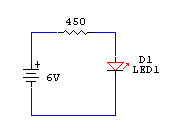Difference between revisions of "Using LEDs & IREDs"
| (One intermediate revision by the same user not shown) | |||
| Line 1: | Line 1: | ||
[[Image:LED.gif|right]] |
[[Image:LED.gif|right]] |
||
<b>Light emitting diodes and infrared emitting |
<b>Light emitting diodes and infrared emitting diodes</b> |
||
LEDs and IREDs are diodes, meaning they conduct in their forward direction only. If their |
LEDs and IREDs are diodes, meaning they conduct in their forward direction only. If their maximum reverse voltage is exceeded, they can be destroyed, and the maximum reverse voltage is sometimes only about 12 volts. |
||
The amount of light emitted is proportional to the forward current. A typical |
The amount of light emitted is proportional to the forward current. A typical continuous forward current that is safe for an LED is 10mA, although an LED can be pulsed briefly to much higher currents without ill effect. Some LEDs are much more efficient than others at converting current to light. |
||
LEDs come in many colors, and even infrared (IREDs.) IREDs are bright and efficient, and the available optoelectronics that detect light ( |
LEDs come in many colors, and even infrared (IREDs.) IREDs are bright and efficient, and the available optoelectronics that detect light (phototransistors and photodiodes) respond best to IR. LEDs can be packaged to emit light in a broad or narrow cone. |
||
LEDs are not resistors: the current through them is *not* proportional to the voltage across them. An LED may be off at 1.0V, dim at 1.5V, and burned out at 2.0V. You do not usually use them with a |
LEDs are not resistors: the current through them is *not* proportional to the voltage across them. An LED may be off at 1.0V, dim at 1.5V, and burned out at 2.0V. You do not usually use them with a voltage source across them, as you would a light bulb. Instead you put a resistor in series with the LED, and you pick the resistor value as follows: |
||
Each kind of diode (including LEDs and IREDs) has a Vf, forward voltage, which depends only weakly on forward current. We'll take it to be a constant. Ordinary Silicon diodes have Vf=0.6V. Most LEDs and IREDs have Vf=1.5V up to Vf=2.0V. For blue LEDs, Vf can be as high as 6.0V. |
Each kind of diode (including LEDs and IREDs) has a Vf, forward voltage, which depends only weakly on forward current. We'll take it to be a constant. Ordinary Silicon diodes have Vf=0.6V. Most LEDs and IREDs have Vf=1.5V up to Vf=2.0V. For blue LEDs, Vf can be as high as 6.0V. |
||
Latest revision as of 14:43, 27 December 2007
Light emitting diodes and infrared emitting diodes
LEDs and IREDs are diodes, meaning they conduct in their forward direction only. If their maximum reverse voltage is exceeded, they can be destroyed, and the maximum reverse voltage is sometimes only about 12 volts.
The amount of light emitted is proportional to the forward current. A typical continuous forward current that is safe for an LED is 10mA, although an LED can be pulsed briefly to much higher currents without ill effect. Some LEDs are much more efficient than others at converting current to light.
LEDs come in many colors, and even infrared (IREDs.) IREDs are bright and efficient, and the available optoelectronics that detect light (phototransistors and photodiodes) respond best to IR. LEDs can be packaged to emit light in a broad or narrow cone.
LEDs are not resistors: the current through them is *not* proportional to the voltage across them. An LED may be off at 1.0V, dim at 1.5V, and burned out at 2.0V. You do not usually use them with a voltage source across them, as you would a light bulb. Instead you put a resistor in series with the LED, and you pick the resistor value as follows:
Each kind of diode (including LEDs and IREDs) has a Vf, forward voltage, which depends only weakly on forward current. We'll take it to be a constant. Ordinary Silicon diodes have Vf=0.6V. Most LEDs and IREDs have Vf=1.5V up to Vf=2.0V. For blue LEDs, Vf can be as high as 6.0V.
In the circuit shown, if you want an LED with Vf=1.5V to have forward current If=10mA, with a 6V battery as shown, you would choose R = (6.0V - 1.5V) / 0.010 A = 450 ohms.
Current flows anode-to-cathode in an LED, in the direction of the arrow in its symbol. Most LEDs have a longer lead to indicate the anode.
Rule of thumb Use a 1000 ohm resistor in series with any LED, with any drive voltage (within reason.)
